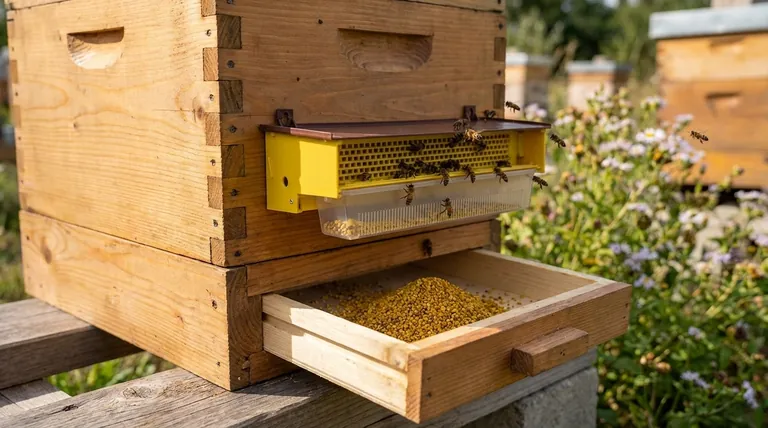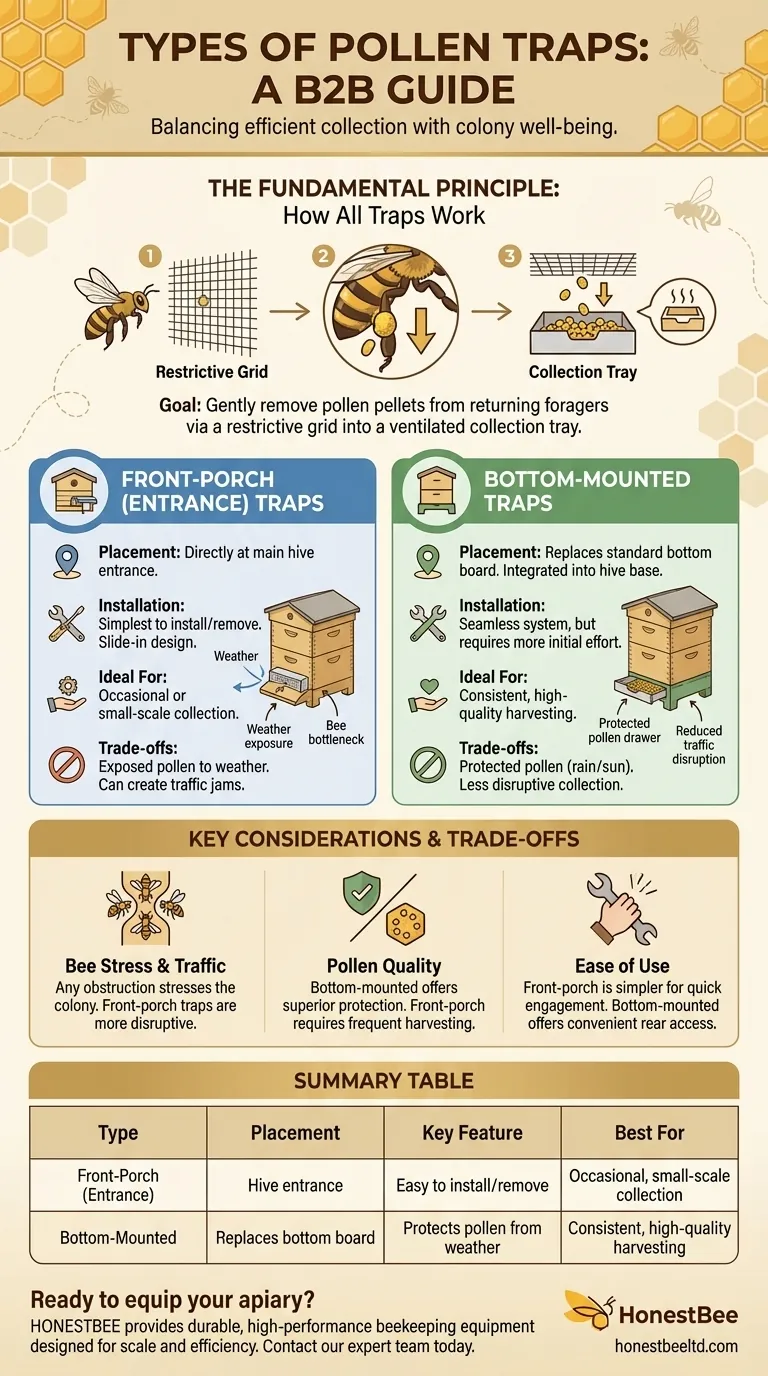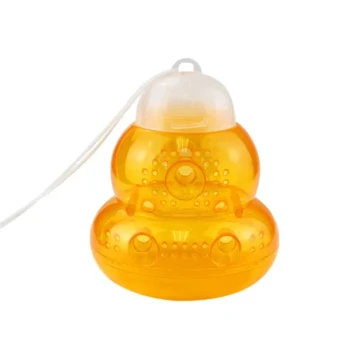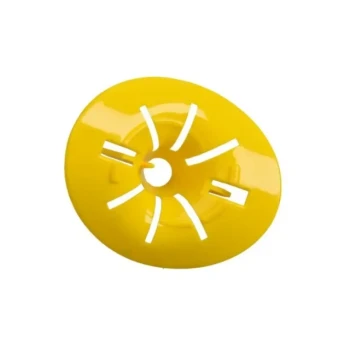The primary types of pollen traps are categorized by their placement on the hive, most commonly as front-porch (entrance) traps and bottom-mounted traps. These designs achieve the same goal through slightly different means, with variations in materials like wood or plastic and the mechanism used to dislodge the pollen from the bees' legs.
The best pollen trap is not determined by its type, but by how well it balances the beekeeper's need for efficient collection against the colony's need for minimal stress and unimpeded operation.

The Fundamental Principle: How All Pollen Traps Work
Before comparing designs, it's crucial to understand the single mechanism they all share. The goal is to gently remove pollen pellets from the legs of returning forager bees without harming them or disrupting the colony excessively.
The Stripping Mechanism
Every trap forces returning bees to pass through a restrictive grid. This is typically a wire mesh screen or a plate with precisely drilled openings.
These openings are just large enough for a worker bee to squeeze through, but small enough to knock the pollen pellets off their hind legs, which are held in specialized "pollen baskets."
The Collection Tray
As pollen pellets are dislodged, they fall through the grid and land in a collection tray or drawer below. This tray is designed to be accessible to the beekeeper, allowing for regular harvesting.
Proper design ensures this tray is well-ventilated to prevent mold but also protected from rain and debris, which could contaminate the valuable pollen.
Analyzing the Primary Trap Designs
The key differences between pollen traps come down to where they are placed on the hive. This single factor influences everything from ease of use to the quality of the pollen collected.
Front-Porch (Entrance) Traps
These traps are positioned directly at the main entrance of the hive, often resembling a small porch or landing board.
They are the simplest to install and remove, often just sliding into place. This makes them ideal for beekeepers who only want to collect pollen periodically.
However, because they are external, the collected pollen is more exposed to weather, and the trap itself can create a traffic jam for bees entering and exiting the hive.
Bottom-Mounted Traps
This design replaces the hive's standard bottom board. The entire trap mechanism is integrated into the base of the hive, creating a more seamless system.
The primary advantage is that the collection tray is located inside the hive structure, protecting the pollen from rain, sunlight, and debris. This generally results in a higher-quality harvest.
While more integrated, they require more effort to install initially. Collection is often done via a drawer that pulls out from the side or back of the hive.
Understanding the Trade-offs
Choosing a pollen trap requires you to weigh the benefits of a particular design against its potential downsides for both you and your bees.
Bee Stress and Hive Traffic
Any obstruction at the entrance can create a bottleneck, stressing the colony. Front-porch traps can be more disruptive to the flow of traffic.
Well-designed traps, regardless of type, will include a separate, larger bypass exit. This allows drones (which are larger than workers) and the queen to leave the hive without having to pass through the restrictive pollen-stripping grid.
Pollen Quality and Protection
Bottom-mounted traps almost always offer superior protection for the collected pollen. By keeping it within the hive's footprint, it is shielded from direct rain and contamination.
Pollen collected from a front-porch trap must be harvested more frequently, especially in humid or rainy conditions, to prevent spoilage and mold.
Ease of Use for the Beekeeper
Simplicity is the key benefit of a front-porch trap. It can be engaged or disengaged in seconds without taking the hive apart.
Bottom-mounted traps with a rear-access drawer are also very convenient, allowing you to collect pollen without disturbing the bees at the busy front entrance.
Making the Right Choice for Your Goal
Your reason for collecting pollen should be the primary factor in your decision.
- If your primary focus is occasional or small-scale collection: A front-porch trap offers the most flexibility and is the easiest to engage and disengage as needed.
- If your primary focus is consistent, high-quality harvesting: A bottom-mounted trap provides superior protection for the pollen and integrates more seamlessly into your hive management.
- If your primary focus is colony health: Prioritize any design with a clear drone escape or bypass port to ensure the natural functions of the hive are not impeded.
Ultimately, the right equipment is a tool that helps you achieve your beekeeping objectives while respecting the well-being of the colony.
Summary Table:
| Type | Placement | Key Feature | Best For |
|---|---|---|---|
| Front-Porch (Entrance) | Hive entrance | Easy to install/remove | Occasional, small-scale collection |
| Bottom-Mounted | Replaces bottom board | Protects pollen from weather | Consistent, high-quality harvesting |
Ready to equip your apiary with the right pollen trap?
As a leading wholesale supplier to commercial apiaries and distributors, HONESTBEE provides durable, high-performance beekeeping equipment designed for scale and efficiency. We can help you select the ideal pollen trap to maximize your harvest while maintaining colony health.
Contact our expert team today to discuss your specific needs and request a wholesale quote.
Visual Guide

Related Products
- Removable Plastic Pollen Trap With Ventilated Tray for Bees Pollen Collector
- 30 cm Plastic Entrance Hole Bee Pollen Trap and Collector
- Plastic Bee Pollen Trap Strips Comb Catcher Collector
- HONESTBEE Advanced Ergonomic Stainless Steel Hive Tool for Beekeeping
- HONESTBEE Professional Long Handled Hive Tool with Precision Cutting Blade
People Also Ask
- What are the key features of an effective pollen trap? Maximize Harvests & Protect Hive Health
- What are important considerations for responsible pollen collection? Sustain Your Hive's Health & Harvest
- What are the primary reasons beekeepers collect bee pollen? Boost Hive Health and Generate Income
- What are the key features of a well-designed pollen trap? Optimize Harvest & Hive Health
- What are the main types of pollen traps? Choose the Right Design for Your Hive's Health



















